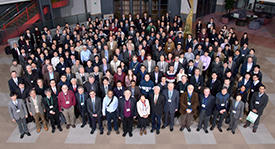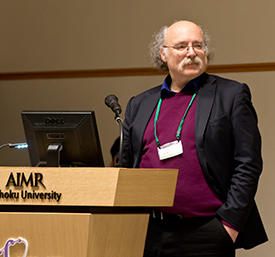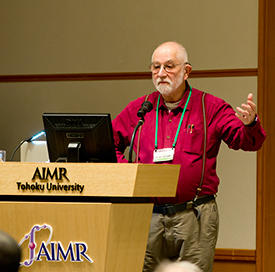

03/30/2015

Prominent physicists, mathematicians and materials scientists converged on Sendai, Japan, to participate in the AIMR International Symposium (AMIS) 2015, held on 17–19 February. Under the theme of “A new horizon for materials science with mathematics collaboration,” the conference showcased many examples of interactions between mathematics and materials science, including the theoretical discovery of previously unknown topologically insulating materials and optical singularities of anisotropic crystals.
Susumu Satomi, president of Tohoku University, made the opening remarks by extending a warm welcome to the participants. In his address, he recognized the excellent research and strong international partnerships initiated at the AIMR under the leadership of Director Motoko Kotani. “AIMR’s experiences have become a driving force for promoting system reform and internationalization of the whole university,” he said. In July 2014, Tohoku University established the Organization for Advanced Studies (OAS), which is modeled on the AIMR and which incorporates the AIMR as the first research institute of the OAS.
Representing the WPI, Deputy Program Director Akira Ukawa shared the results of a 2014 review of five WPI centers, including the AIMR. The goals of the WPI program are to produce top-quality science and initiate internationalization, fusion studies and research systems reform. Ukawa remarked that all five centers had achieved World Premier Status by fully meeting these ambitious goals. “The WPI Program Committee was impressed by the extremely high levels of science being advanced by the five WPI centers,” said Ukawa, who cited, among other examples, their significant contributions to the top one per cent of most highly cited papers published between 2007 and 2013, according to an analysis by Thomson Reuters. “All five centers achieved World Premier Status.” Furthermore, Ukawa noted that the AIMR had made remarkable progress in mathematics–materials science collaboration under the leadership of Kotani and had realized a highly international research environment by implementing a number of system reforms.
Speaking next, Kotani offered a personal introduction to the AIMR and its research goals. “In 2011, we made our identity clear, which is to create a basis for new materials science that predicts functions and designs structures through mathematics and materials science collaboration,” she said. “Such institution-level collaboration is unprecedented and has invited significant interest from both communities.” She encouraged participants to attend the poster session, where close to 100 displays offered tangible proof of the merits in AIMR’s approach.
The first scientific presentation of the day was by Duncan Haldane, professor of physics at Princeton University and 2012 Dirac medalist for advancing our understanding of curious materials known as topological insulators, which conduct electricity only on their surfaces. Haldane shared the story of how these materials were theoretically predicted before they were experimentally observed, eventually becoming the hottest topic in condensed-matter physics. “Topologically insulating materials existed on shelves in labs under the noses of materials scientists,” he said. “But no one told them that they should be looking for something interesting there.”

Variants of the topological insulator state that exhibit unique quantum phenomena have since been observed in two- and three-dimensional materials, bringing with them the promise of spintronic devices and practical quantum computers. In one example, researchers have discovered materials that physically separate electrons traveling in different directions to enable the one-way movement of information — “like in a divided highway,” Haldane explained.
Speaking next was Sir Michael Berry, professor of physics at the University of Bristol in the United Kingdom and recipient of the 1995 Dirac medal for his discovery of a widespread effect in microscopic physics known as the Berry phase. Berry took the occasion to celebrate the 2015 International Year of Light from the perspective of geometry. Light with an electric field oscillating in a single direction, known as polarized light, is often used to identify crystal properties. “Every mineralogist knows this old technique,” said Berry. He decided to instead use crystals to identify the polarization structure of light. “Crystal optics is a nineteenth-century subject, but a lot is hidden in it that hasn’t been extracted,” said Berry. When polarized light waves cross paths, they form distinct points known as singularities. Berry identified several types of singularities using crystal models. “These singularities are fundamental to light.”

Returning to the subject of condensed-matter physics, Erio Tosatti, a professor at the International School for Advanced Studies in Italy, discussed the merits of deeper collaboration between two theoretical camps in the branch of physics that explores the properties of matter. On one side are inventors of simplistic models, which Tosatti likened to the wooden puppet Pinocchio. And on the other side are those who perform realistic calculations and simulations to “transform the puppet into a real boy,” said Tosatti. “Both approaches are clearly essential.” He offered three examples of his group’s attempts to bring the two closer together in the areas of strongly correlated superconductivity, current transport through nanocontacts and friction. “It is for the present generation to find formulations that join models and realistic calculations together,” he said.
Researchers who discussed specific materials at the meeting included Petros Sofronis, director of another WPI institute called the International Institute for Carbon-Neutral Energy Research (I2CNER), and Thomas Russell, a principal investigator at the AIMR.
I2CNER is currently pursuing research that will bring us closer to an economy based on hydrogen, from production through to transport, storage and ultimate consumption in fuel-cell vehicles. “In all these applications, materials are exposed to hydrogen, and we need to worry about their interaction,” said Sofronis, who offered a tentative diagnosis for a specific type of material failure caused by hydrogen that is poorly understood — hydrogen embrittlement. “We need to develop predictive models on how to tame the problem of hydrogen embrittlement,” he said.
Russell introduced an entirely new class of materials that lie on the border between a liquid and a solid. By mixing two repellent liquids, such as water and oil, with functionalized nanoparticles and polymers, his team was able to create liquid droplets that had arbitrary solid shapes by applying an external field, like elongated teardrops, for example. Even after removing the external field, these structured liquids retained the deformed shape and properties of the two original liquids, a peculiarity that could be exploited to produce liquid circuits and all-liquid batteries, among other applications. “We have taken one plus one to get something other than two,” said Russell.
The final speaker of the opening session was Kazuyuki Aihara, professor at the University of Tokyo in the field of mathematical engineering. Aihara shared his work on developing mathematical models of neural networks that could contribute to an artificial quantum brain. He demonstrated an example of a two-million-dimensional chaotic neural system that can retrieve stored images successively, intermittently and chaotically. “Just as human beings invented airplanes in the likeness of birds, we can make a very strong information processing machine inspired by the brain,” he said.
“I am really proud to have been able to invite researchers who are leaders in their field in the contemporary and historical sense,” said Kotani of AMIS2015. Attending the conference were 268 researchers representing 36 research institutes across 14 countries, including 34 invited speakers. The opening session was followed by three days of plenary and parallel sessions. “I promise to continue our efforts to act as a world leader in our research area and contribute to society.”